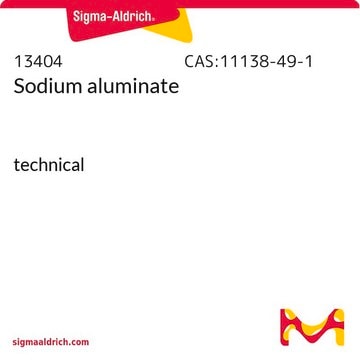307815
Sodium metasilicate
Synonym(s):
Disodium metasilicate, Disodium silicate, Sodium silicate, Sodium silicon oxide
About This Item
Recommended Products
composition
SiO2, 50-53%
Quality Level
SMILES string
[Na+].[Na+].[O-][Si]([O-])=O
InChI
1S/2Na.O3Si/c;;1-4(2)3/q2*+1;-2
InChI key
NTHWMYGWWRZVTN-UHFFFAOYSA-N
Looking for similar products? Visit Product Comparison Guide
General description
Application
- Hydrothermal preparation of thorium uranium silicate (Th1-xUxSiO4) uranothorite solid solutions
- Fabrication of dense NaA zeolite coatings
- Reactant for preparation of tungsten modified silica as catalyst for liquid phase oxidation of styrene
SMS can also be used:
- To prepare NaZnSiO3OH, a novel chiral framework material which has potential application in ion exchange, adsorption and catalysis.
- As a low-cost alternative to tetraethyl orthosilicate (TEOS) to synthesize highly ordered mesoporous silicas.
- To prepare geopolymer concrete.
Signal Word
Danger
Hazard Statements
Precautionary Statements
Hazard Classifications
Eye Dam. 1 - Met. Corr. 1 - Skin Corr. 1B - STOT SE 3
Target Organs
Respiratory system
Storage Class Code
8B - Non-combustible corrosive hazardous materials
WGK
WGK 1
Flash Point(F)
Not applicable
Flash Point(C)
Not applicable
Personal Protective Equipment
Certificates of Analysis (COA)
Search for Certificates of Analysis (COA) by entering the products Lot/Batch Number. Lot and Batch Numbers can be found on a product’s label following the words ‘Lot’ or ‘Batch’.
Already Own This Product?
Find documentation for the products that you have recently purchased in the Document Library.
Our team of scientists has experience in all areas of research including Life Science, Material Science, Chemical Synthesis, Chromatography, Analytical and many others.
Contact Technical Service








